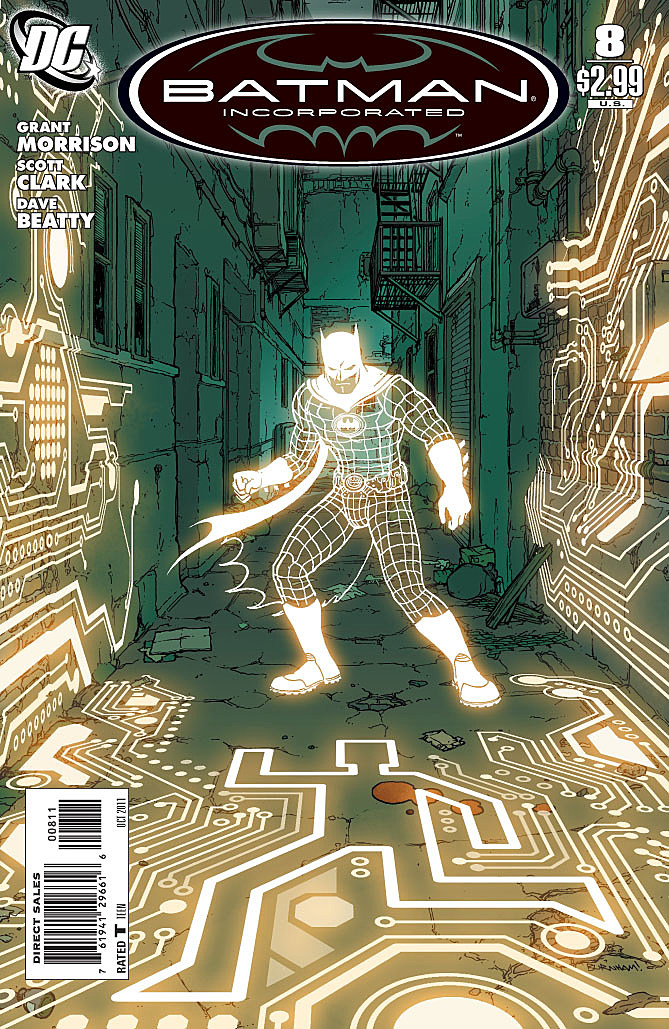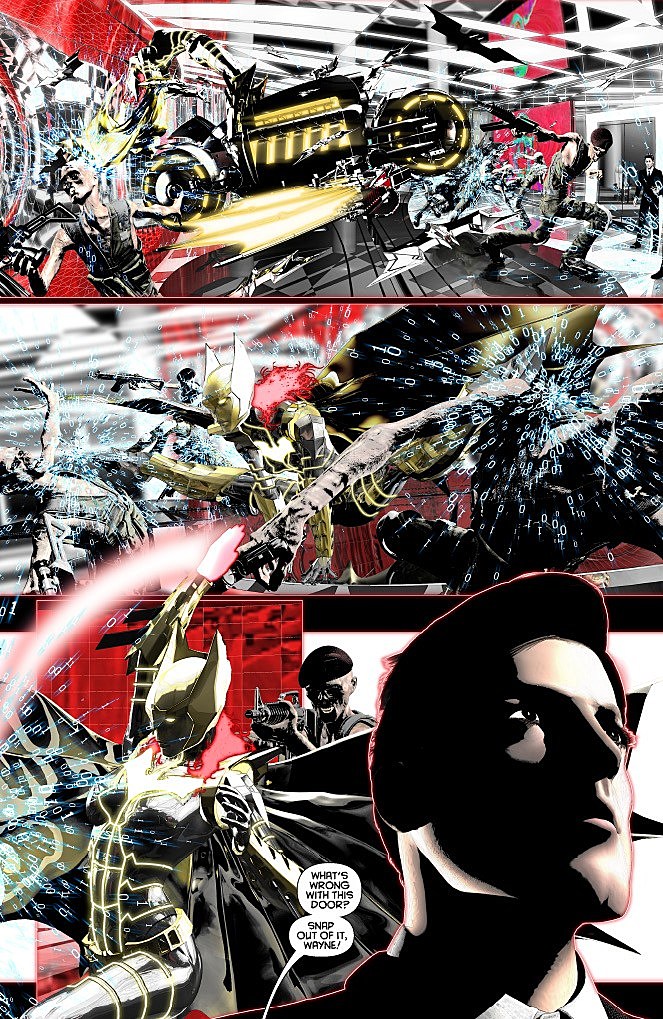![‘Batman Incorporated’ #8: Abort, Retry, Fail [Review]](http://townsquare.media/site/622/files/2011/08/inc801.jpg?w=980&q=75)
‘Batman Incorporated’ #8: Abort, Retry, Fail [Review]

At the end of Batman Incorporated #7, there was this great teaser image for the next issue where Oracle called Batman as he suited up in a crazy Tron-esque version of his costume, with the dialogue "Calling Batman! Big trouble in Internet 3.0!" It's beautifully over-the-top, but at the same time, the idea of a 21st Century Batman fighting the comic book version of the Internet crime in a comic written by Grant Morrison, a guy known for making wild ideas work in his super-hero comics, is something I was looking forward to seeing.
This week, Batman Inc. #8 finally hit the stands, and as far as I can tell, the "big trouble" in this story is that it's a genuinely awful comic book.Most of the blame can be aimed squarely at the art team of Scott Clark and Dave Beatty, who turn in 20 pages that wouldn't even pass muster on DeviantArt. The choice to go with computer-generated artwork sort of makes sense in the context of the story, as it takes place entirely within a Virtual Reality simulation Wayne Industries has made to replace the Internet. In practice, however, it's one of the worst looking comics I've ever seen from a major publisher, and it's only underscored by the fact that the very first panel of the book involves the characters talking about how awesome everything looks.

The dialogue itself draws your attention to the stiff, lifeless figures set against eye-searing backgrounds, and while the characters certainly seem impressed at being rendered as NPCs in a low-res port of Saints Row, I wasn't.
Those opening panels, by the way, might as well be the most action-packed shots in the book, because every single panel is about as exciting as watching a guy touch a window. Even when Batman's using his online avatar to cyberpunch an virtual terrorist's techno-head off his e-body, there's no motion or energy to any of it. When the action does hit, the solution they seem to have hit on seems to be to dump digital speed lines all over everything in an effort to spice things up, but it just clutters up the pages until you can't tell what's going on. Sure, you could probably figure it out if you stared at it long enough, but when it looks like this, why would you want to?
In short, everyone is... well, I was about to say they looked like artfully posed mannequins, but that doesn't even really cover it, so let's just take a look at an actual panel from this comic:

Hilarious.
And believe it or not, the backgrounds are even worse.

Every page is rendered in this high-contrast palette of black, white and bright red that I think may have been chosen to echo video games, in that they make you want to see if there are contrast and color settings on your comic that you can adjust until you can look at it without needing welder's goggles. They seem designed less for ease of storytelling and more to drive up sales of aspirin by giving everyone who reads it a splitting headache.
It's actually painful to read -- and when the plot shows up, it gets excruciating.

As I mentioned, the story takes place entirely within Bruce Wayne's virtual reality world, and I don't know if this was Morrison's attempt to get back at the Wachowskis for ripping off The Invisibles, but with the sheer amount of Matrix-Lite nonsense he's dealing with here, I'd say he's settled the score.
Basically, Bruce Wayne is having a meeting with some investors from across the world in his online digital CyberGotham, presumably because when you invent Second Life eight years too late, you need to get some rich people together to bail you out. Anyway, some bad guys show up and start causing trouble, so Batman's Batman avatar and Oracle's Batgirl-Of-The-Internet avatar team up to stop them by treating the whole virtual world like a video game.
That's actually not a bad concept, except that it feels like it's executed by someone who hadn't actually played any video games, but rather had them described to him by a very excitable child. There's a reference to Batman getting a "power-up," but the art's so bad that I can't really tell what that means in the context of the story. He certainly doesn't grow twice his size and start breaking bricks, and it doesn't seem to have any impact whatsoever on what's going on. It's just a video game term, hanging in the air in complete isolation from anything around it.
There's also a moment where he shouts "Respawn!" after he falls down a pit only to show up safe and sound to try that grappling hook shot again, and while I can recognize that this can be kind of funny if it's pulled off correctly, the whole thing seems like one massive misstep after another. The overall effect isn't too far removed from those made-for-TV movies about cybercrime from the '90s, where cops stared at massive CRT monitors saying things like "He's sending a packet through the modem! Can we stop him?" "No chance. He's on a 56K -- he'll be through our firewall and into the CPU core in no time!" "Can you execute a trace?" "I'm trying, but he's boucing the signal through a secure off-site server!" The only thing Morrison's missing is an animated gif of a laughing skull showing up to remind them that U JUST GOT HAXED BY TH3_J0KER_FI5H.

Right at the beginning, the bad guys tell Wayne's investors that they can't log off the VR simulation -- and yes, this comic came out this year -- they'll die. Or maybe they'll just lose all their money; they mention "the ultimate price," which I assumed was being killed because that's what that phrase has meant every other time I've read it, but as David Uzumeri points out, they later talk about losing their fortunes. Either way, they never really give a reason for it, or for why they run away as though it would be dangerous for them to get hurt, since it's all in a simulation. I've always been a defender of Morrison's scripts against complaints that he doesn't spell everything out, but here, the unspoken reason seems to just be that this is how it is in this kind of story.
And that might be the worst part of the story: There's nothing new here. We've all seen the "trapped in virtual reality" story done better than this, and most of us have even seen that sort of story done better than this with Batman, thanks to the Animated Series. But the thing is, this could've been done in a whole new way, and it even looked like it was going to be. The teaser from #7? It has nothing to do with what actually happens in this comic. The awesome Chris Burnham cover, with Batman examining a "chalk" outline, suggesting a locked room mystery with the entire Internet as the locked room? Doesn't happen.
Instead we get a low-stakes action story with a halfass mystery, as depicted by screenshots from MadWorld for the Wii.

And as a final reason for you to shake your head at this one, it's actually capped off with a huge reveal for the overarching Batman Inc./Leviathan storyline, but it's delivered in the worst way possible, in a way that -- as our resident annotator David Uzumeri pointed out -- hinges on a piece of information that has been held back from the stories for the past five years. And here it is now, dumped into this one.
During those years, I've been a huge fan of Morrison on the Batman books, and up until this issue, I've thought that Batman Inc. has been nothing short of phenomenal. This, however, is a comic so bad that it makes great comics worse.
Preview of Batman Incorporated #8:






More From ComicsAlliance









